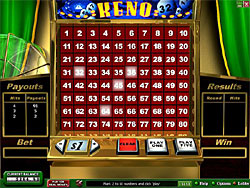
Keno
Keno
The game of keno uses 80 balls numbered 1 thru 80. Each game, the house draws 20 balls at random and displays the numbers on screens, called keno boards, located throughout the casino. The object of the game is for the player to guess some of the numbers the house will draw.
 Players mark a keno ticket, which is a piece of paper with the numbers 1 thru 80 printed on it. Keno tickets are located at tables scattered throughout the casino, but most are readily found in the keno lounge, an area with chairs to sit and write. Usually crayons or pencils are provided for marking the tickets.
Players mark a keno ticket, which is a piece of paper with the numbers 1 thru 80 printed on it. Keno tickets are located at tables scattered throughout the casino, but most are readily found in the keno lounge, an area with chairs to sit and write. Usually crayons or pencils are provided for marking the tickets.
Before marking a ticket, players must decide how much money they want to gamble on the ticket. The house’s keno brochures are normally kept near the tickets. These brochures tell players what the standard bets and payouts are. All casinos tend to have similar betting/payoff scales, but on occasion there are various "house specials" available. Here is an example from a typical keno brochure.
Play 6 numbers
| Catch |
play $1 |
play $2 |
play $5 |
| 3 |
$1 |
$2 |
$5 |
| 4 |
$ 8 |
$ 16 |
$ 40 |
| 5 |
$ 50 |
$ 100 |
$ 250 |
| 6 |
$ 1500 |
$ 3000 |
$ 7500 |
Play 6 numbers pertains to the payoffs players would be paid if they marked 6 numbers.
Numbers are also known as spots. If a player plays 6 numbers he is said to be playing a 6-spot. Players can play more or fewer than 6 spots.
Catch refers to how many of the player’s chosen numbers match what the house draws.
Play $1 means the player can bet $1 on the ticket. Although the table shows that players can bet more than $1, there is no percentage advantage to betting more than the minimum, as payoffs are scaled by the amount bet.
If a player marks and catches all 6 numbers, a $1 ticket will return $1500. The odds of this happening are slightly over 7500 to 1. It does happen, but not often.
If the player "only" catches 5 numbers the payoff is substantially less, down to a $1 payoff for catching any 3 of the 6 selected. If the player catches fewer than 3, the ticket is worthless.
The payoff is on a "for" basis rather than a "to" basis, meaning if the player collects $8 for matching 4 numbers, since the player has already paid $1 for the ticket he is actually "winning" $7.
Players may mark a ticket with anywhere from 1 to 15 numbers, although the more numbers chosen, the more that have to be caught. The payoffs are set such that the house percentage is pretty much the same regardless of how many numbers are marked. Players can choose to some extent if they want several small wins or fewer, larger wins.
|

